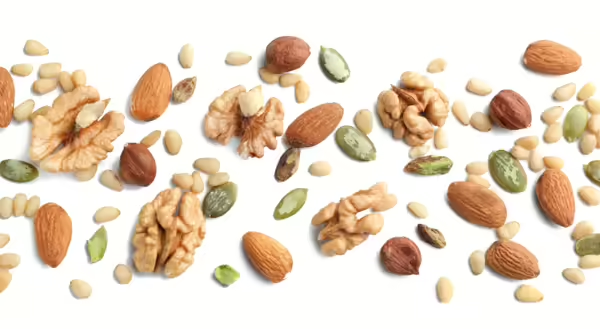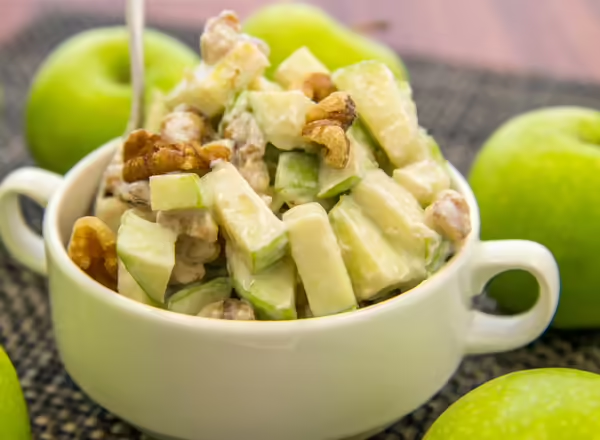
What are your favorite nuts and seeds? Maybe pecans or walnuts? Sunflower or pumpkin seeds? Fortunately, no matter your favorites, nuts are a nutritious choice!
Nutrition
Nutritionally, 1/4 cup of most nuts and seeds - or 2 Tablespoons nut butter - contains 14-18g fat, 5-7g protein, 2-4g fiber, and are sources of vitamins and minerals including B vitamins, vitamin E, magnesium, zinc, potassium, and iron. A majority of the fat in nuts and seeds are heart-healthy unsaturated fats. On their own, nuts are not a significant source of carbohydrates or sodium.
Shop
Practice reading labels on nut and seed packages and choose types that meet your nutrition needs. For example, if you are focused on eating less salt, choose reduced-sodium or no-salt-added nut and seed products.
- Raw Nuts. Find raw nuts and seeds either still in their shells or cracked out of their shells. Stores may sell raw nuts and seeds in bulk bins or pre-measured in sealed containers.
- Dry- or Oil-Roasted. For a richer flavor, try dry- or oil-roasted nuts and seeds, available salted or unsalted.
- Flavored Nuts. When you are looking for something unique, enjoy nuts coated with sweet, savory, or spicy seasonings. Sweet coatings are often honey or a candy coating. Savory seasonings may include onion and garlic. Spicy blends often use hot peppers for heat.
- Nut Butters.
- "Natural" nut butters contain only blended nuts (and maybe salt). The oil and nut solids separate over time and need to be stirred before using. (Instead of a knife, I like using an electric hand mixer - and a flexible jar opener to grip the jar tight - to blend the nut solids and oils back together.)
- With "no stir" nut butters, the oil is prevented from separating by adding fats, sugar, or other ingredients.
- Reduced-fat nut butters have 25% less fat than the original product. Reduced-fat products may add sugar or salt to compensate for a change in flavor from less fat. Because nuts and nut butters have heart-healthy unsaturated fats, I recommend buying full-fat nut butters.
- Nut powders. By adding water, nut powders turn into a spreadable nut butter. Most brands are defatted, making the nut powder low in fat. While useable as a nut butter, nut powders can also be added to smoothies, baked goods, or oatmeal for a small boost in protein and nutty flavor.
Whatever type of nuts and seeds you buy, remember they contain fat that will become rancid over time, which you may notice as an "off" taste. Check "best-by" or "use-by" dates to buy the freshest nuts available and read the Storage section for more tips.
Price
Because nuts are a resource- and labor-intensive food to grow and process, nuts can be expensive. Buying larger packages can cut down on the unit price (such as dollars per pound), but make sure you plan to use the nuts in a timely manner before they start to go rancid.
While it might not save money, support local nuts growers in your county who will have a very fresh product. Or explore free foraging options in your area for black walnuts.
Store
Store nuts and seeds at room temperature for several weeks and months in air-tight containers. Nuts can also be refrigerated or frozen for longer storage, which will help slow down how quickly the fats turn rancid. Follow storage recommendations as written on the product. For example, "natural" peanut butters may recommend refrigeration after opening.
Prepare
- Ready-to Eat. Unless the nuts are in the shell, simply open the package and eat. It's that simple!
- Chopping Shelled Nuts. Add nuts to a food processor or clean coffee grinder and pulse, place nuts in a sealed bag and lightly pound with the side of a meat mallet or use a knife and cutting board to chop until you reach the desired size pieces.
- Removing Shells. Use a nutcracker carefully to remove the nut meat inside. Some companies may sell cracked nuts with some shell still attached. These shells can often be removed using just your hands and a little effort.
- Soaking or Not Soaking? Claims that "activating" nuts or seeds with soaking to make nuts more easily digestible or to improve nutrient absorption are not supported by research. In some research, soaking - particularly for long periods of time or at room temperature - increased the growth of salmonella bacteria.
Preserve
Did you know you can pressure can green peanuts at home? Check out instructions from the National Center for Home Food Preservation.
Make
Making your own nut butters is easy with a food processor. See the DIY: Make Your Own Nut Butter blog post for recipe instructions. But, be sure to use pasteurized nuts. While nuts and seeds are a low-water or low-moisture food, they can still hold onto salmonella bacteria and other pathogens that can make humans sick.
Store-bought nuts and seeds will be treated with heat for a short amount of time to kill off those pathogens, but nuts collected from backyard orchards or foraging have not been pasteurized yet. See Growing Nut Trees in Illinois below for more on pasteurization.
Eat
Nuts and seeds add crunch and nutrition to so many recipes. Here's a short list of five ways to eat them. What else would you add?
- Mix into baked goods like cakes, muffins, and quick breads.
- Prepare nut-based sauces like pesto or cashew cream.
- Add as a topping to leafy green salads, yogurt, or oatmeal.
- Chop fine to use as a crust on chicken or fish.
- Add nut butters to fruit smoothies. (Maybe a chocolate, peanut butter, and banana combo!)
Growing Nut Trees in Illinois
Illinois is the right climate for growing a variety of nut trees. Watch these Growing Good webinars from Illinois Extension for information about chestnuts, walnuts, pecans, and hazelnuts: Going Nuts Over Tree Nuts and Growing Hazelnuts in Illinois.
Learn ways to pasteurize nuts with Nuts and Nut Pastes resources from University of California, Davis.
Resources:
- Braun C (2024). How to Make a Safe Nut Butter, South Dakota State University Extension
- Bruhn C, et al (2010). Nuts: Safe Methods for Consumers to Handle, Store, and Enjoy, University of California, Davis
- Emch A, et al (2021). Salmonella Growth during the Soaking Step of “Sprouted” Grain, Nut, and Seed Production. Food Protection Trends, Vol 41, No. 3, p. 314–322
- Feng, B (2021). Are Dry Foods Safe Foods? Food Safety Implications of Low-moisture Foods, Purdue University
- Feng Y at al. (2020). Growth and Survival of Foodborne Pathogens during Soaking and Drying of Almond (Prunus dulcis) Kernels. Journal of Food Protection. Vol 83, no. 12, pp. 2122-2133. doi: 10.4315/JFP-20-169
- Kumari S, et al. (2020).Does ‘activating’ nuts affect nutrient bioavailability?, Food Chemistry, Vol 319
- Swinehart M, et al (2024). Food Safety Implications of Online Recipes for Preparing Soaked Nuts and Nut-Based Dairy Analogs, Food Protection Trends, Vol 44, no. 1, pp. 19-35, doi: 10.4315/FPT-23-016
- Taylor H, et al (2017). The effects of ‘activating’ almonds on consumer acceptance and gastrointestinal tolerance, European Journal of Nutrition, Vol 57, pages 2771–2783
- U.S. Department of Agriculture, FoodData Central
Post originally published in 2014; content updated in 2025.
About the Author: Caitlin Mellendorf is an Illinois Extension Nutrition and Wellness Educator serving DeWitt, Macon and Piatt Counties in Central Illinois. She is a Registered Dietitian and her work focuses on helping community members gain the knowledge, skills and tools to live healthier, more nutritious lifestyles. This includes providing programs and answering questions about heart health, diabetes, food safety, food preservation, grocery shopping and cooking. You can reach Caitlin by email at chuth2@illinois.edu or call 217.877.6042.
